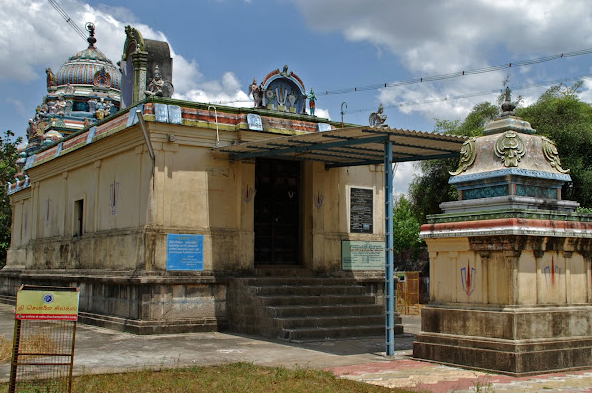- Sri Varadaraja Perumal Temple is also called Thiru Mani koodam /Sri Varadaraja Perumal Temple.
- Thirumanikoodam or Varadaraja Perumal Temple is located in Thirunangur, a village in the outskirts of Sirkazhi in the South Indian state of Tamil Nadu, is dedicated to the Hindu god Vishnu.
- It is one of the 108 Divyadesam dedicated to Vishnu, who is worshipped as Varadharaja Perumal.
- This temple is in the 37th place of the 108 Divya Desams.
- It is one among the eleven divyadesams of Thirunangur Tirupathis and is closely associated with Thirumangai Alvar.
- It is also the only temple in the Nangur divya desams to have been revered by an azhwar other than Thirumangai Alvar.
PURANIC SIGNIFICANCE 1:
- The Legend is common for all the 11 temples of Thirunangur, and it is about Vishnu appearing before Shiva to control his anger and bring balance to the cosmos.
- Once, Goddess Sati, Shiva’s consort, went to attend the sacrifice conducted by her father, Daksha, against Shiva’s wish.
- Daksha had a grudge against Shiva, as he had plucked out one of the heads of Brahma, Daksha’s father.
- So, while Daksha invited many dignitaries to the ritual, he ignored his son-in-law Shiva.
- In the sacrifice too, Sati was greatly belittled by Daksha, and unable to take the insult, she jumped in the sacrificial fire and killed herself.
- This tragedy proved too much for Shiva to bear, and he went wild and started doing his cosmic dance.
- And every time his tuft of hair touched the earth during the dancing, 11 new embodiments of Shiva, got generated from there.
- As this could spell doom for the universal beings, the Devas and other celestials pleaded with Lord Vishnu to end this dance of destruction and restore balance in the universe. Accordingly, Vishnu is said to have assumed 11 forms and brought Shiva under control.
- It is said that these 11 Vishnu forms are worshipped as the principal deities of the 11 Thirunangur Tirupathi temples.
PURANIC SIGNIFICANCE 2:
- Thakkan had 27 daughters.
- The Moon married all the 27 daughters of Thakan.
- The Moon promised Thakan that he would love all the 27 wives equally and not be biassed towards anyone.
- But the moon was with great love only to Rohini. So all the other daughters appealed to their father.
- So Thakkan cursed the Moon to decline his beauty and light every day.
- The Moon started to decline every day.
- To get redressed from the curse he went to many temples and finally reached Thirumanikudam.
- The Lord Vishnu (Perumal) appeared in the form of Varatha Raja Perumal and removed the curse of the Moon.
PURANIC SIGNIFICANCE 3:
- Tirumanaiazhwar addresses this Perumal as one with Mahalakshmi on His Chest so there is no separate sannidhi for Thayar in this temple. Perumal’s thirunakshatram is Thai Poosam.
- Lord of this place has chandran as ornament and Garuda as vehicle and poses as Lord Varadharaja.
- He gave special darshan to Lord Chandra and Garuda here Lord Shiva has river Ganges and Lord Chandra, the Lord of this place too has the same Lord Chandra and Lord Garuda instead of river Ganges and poses as Lord Varadharaja .
- This is an act of illustrating the unity between the Lord Shiva and Lord Vishnu.
- As the Lord Shiva solved the curse of chandran, here Lord Vishnu also once saved Chandra from his Curse and hence the Pushkarani is named as Chandra Pushkarani.
- The Lord Varadharaja is known for his act of bestowing abundant wealth to his devotees and this act brings the name of the Vimanam as Kanaka – gold Vimaanam.
- The rays of Lord Chandra are as soft as light rays emerging out of Pearls, Crystals etc. Which are known as manigal and as Lord Varadharaja gave darshan to Chandran. This place is called “ThiruMani Koodam”.
